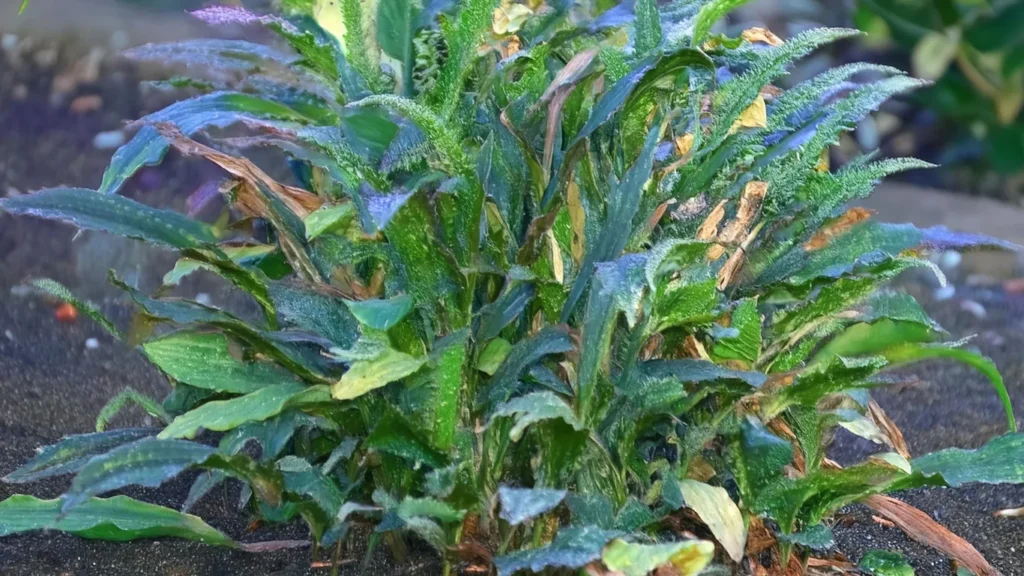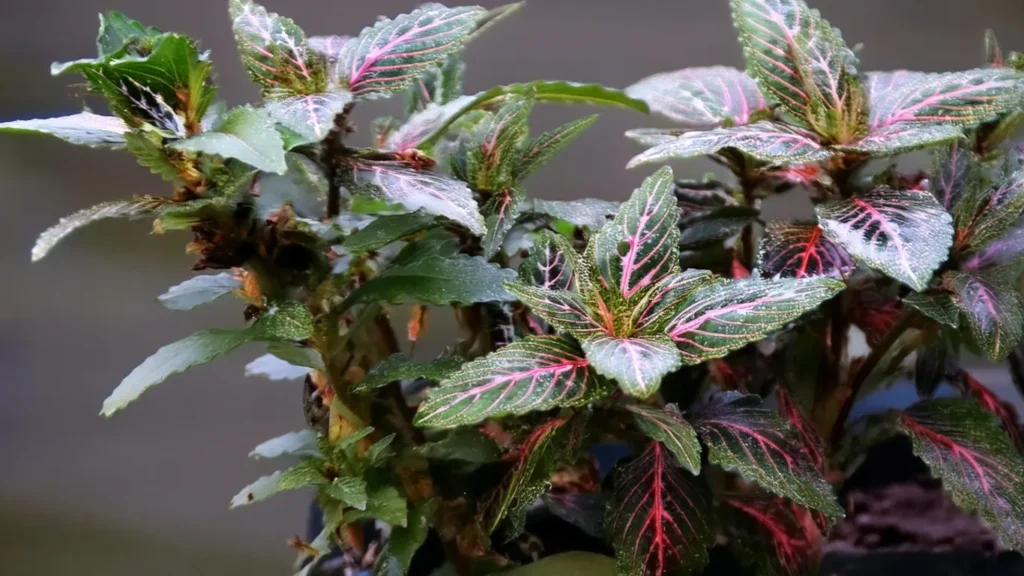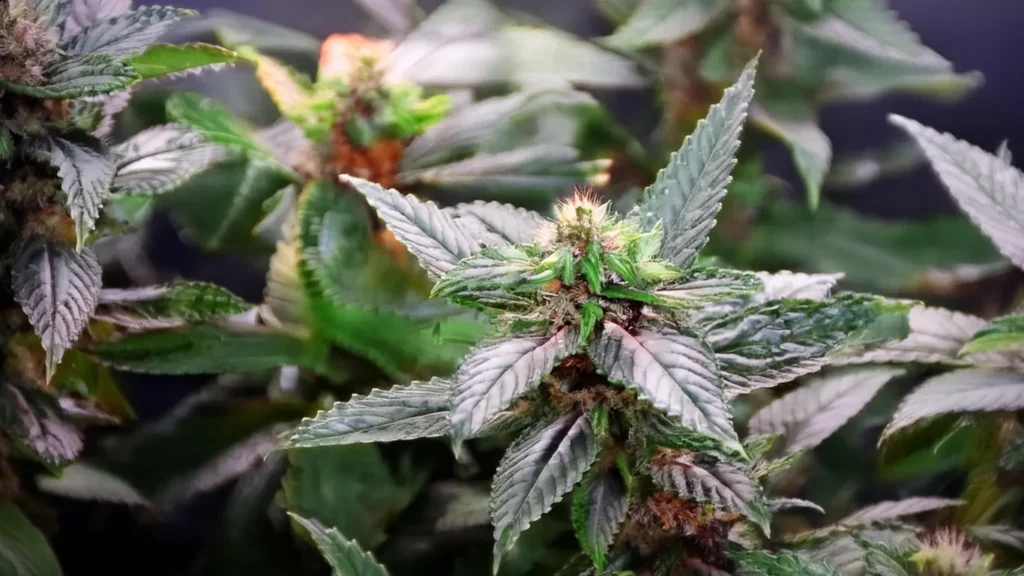Welcome to our comprehensive guide on Bucephalandra Biblis! As avid aquarium enthusiasts, we understand the excitement and joy of cultivating unique and captivating aquatic plants.
Bucephalandra Biblis is one such plant that has gained popularity among aquascapers for its stunning appearance and versatility.
In this guide, we will delve into the care and cultivation of Bucephalandra Biblis and explore the unique features that make it a desirable choice for any aquarium.

With its ornamental appearance and vibrant colors, Bucephalandra Biblis adds a touch of elegance and natural beauty to any underwater landscape.
Whether you are new to aquascaping or a seasoned enthusiast, this guide will provide valuable insights and tips to help you successfully care for and cultivate Bucephalandra Biblis in your aquarium.
From understanding the basics of Bucephalandra care to incorporating it into your aquascapes, we’ve got you covered. Let’s dive in!
Key Takeaway
- Bucephalandra Biblis is a unique and captivating aquatic plant highly regarded for its ornamental appearance.
- Proper care and cultivation techniques are essential for the health and growth of Bucephalandra Biblis.
- Understanding the ideal water conditions, nutrient needs, and lighting requirements is crucial for optimal growth.
- Bucephalandra Biblis can be incorporated into aquascapes with other plant species and hardscape integration techniques.
- Propagation techniques, such as rhizome cuttings, can expand your collection of Bucephalandra Biblis.
Quick Stats
| Attribute | Details |
| Family Name | Araceae |
| Origin | Borneo, Indonesia |
| Height | 5-10 cm (2-4 inches), depending on conditions |
| pH Range | 6.0 – 7.5 |
| CO2 Requirement | Low to Moderate |
| Growth Rate | Slow to Moderate |
| Care Level | Moderate |
| Color Form | Green leaves, some varieties may display blue, purple, or red hues |
| Water Conditions | 20-28°C (68-82°F), soft to moderately hard water |
| Max Size | Leaves can vary greatly in size, typically 2-5 cm (0.8-2 inches) wide |
| Lighting | Low to Medium |
| Supplements | Benefits from CO2 and micronutrient dosing, particularly iron |
| Placement | Attached to rocks or driftwood; can be planted in substrate but ensure rhizome is above ground |
| Propagation | Rhizome division or by adventitious shoots |
What Is Bucephalandra Biblis?
Bucephalandra Biblis is a species of aquatic plant belonging to the genus Bucephalandra within the family Araceae. It is a popular choice among aquarium enthusiasts for its attractive appearance and relatively low maintenance requirements.
Bucephalandra plants are native to Borneo, particularly in areas with flowing streams and rivers.
Biblis is characterized by its deep green, slightly ruffled leaves that often exhibit a reddish or purplish hue under suitable lighting conditions. It is a slow-growing plant that typically thrives in low to moderate lighting and can be propagated by dividing the rhizome or by growing new plantlets from the edges of mature leaves.
Bucephalandra Biblis is prized for its ornamental value and is often used in aquascaping to add texture, color, and visual interest to aquarium layouts.

Natural Habitat And Origin
Bucephalandra Biblis originates from the island of Borneo, particularly in regions with flowing streams and rivers.
Its natural habitat includes tropical rainforests and riparian zones where it grows attached to rocks or driftwood submerged in shallow, fast-flowing water.
Borneo’s humid climate and abundant rainfall create ideal conditions for the growth of Bucephalandra species, including B. Biblis.
These plants are adapted to thrive in low-light environments beneath the forest canopy, where they play a crucial role in aquatic ecosystems, providing shelter and habitat for various aquatic organisms.
Physical Characteristics Of Bucephalandra Biblis
- Leaves: The leaves of Bucephalandra Biblis are typically deep green in color and have a slightly ruffled or undulating texture. They are generally oval-shaped with pointed tips and smooth margins. Under suitable lighting conditions, the leaves may exhibit a reddish or purplish hue, especially along the leaf margins or undersides.
- Size: The size of Bucephalandra Biblis leaves can vary depending on environmental factors and growth conditions. They typically range from 2 to 5 centimeters in length and 1 to 3 centimeters in width.
- Rhizome: Like other Bucephalandra species, B. Biblis grows from a rhizomatous stem that attaches to surfaces such as rocks or driftwood. The rhizome produces roots that anchor the plant to the substrate and absorb nutrients from the surrounding water.
Water Conditions For Proper Growth
- Creating the right water conditions is essential for the well-being of Bucephalandra Biblis. It thrives in slightly acidic to neutral water with a pH range of 6.0 to 7.5.
- Additionally, maintaining water hardness between 2 to 10 dKH is recommended. It is important to ensure good water circulation and oxygenation in the aquarium to support healthy growth. Adding a powerhead or air pump can help achieve this.
- Regular water changes of 10-20% every week are necessary to keep the water clean and clear. This helps remove accumulated toxins and ensure a stable and consistent environment for the plant.

Lighting Requirements For Optimal Growth
- Proper lighting is crucial for Bucephalandra Biblis’s growth and coloration. Moderate to high lighting levels are recommended for this plant to thrive.
- The ideal is a minimum of 0.5 watts per liter of full-spectrum light, which can be achieved using LED lights or compact fluorescent bulbs.
- It is essential to provide a good balance between light intensity and duration. Bucephalandra Biblis should receive 8-10 hours of light per day to support photosynthesis and ensure healthy growth. The use of a timer can help maintain a consistent lighting schedule.
- It is important to note that the lighting requirements may vary depending on the specific aquarium setup and other factors.
RELATED: The Aquatic Wonder Bacopa Australis To Transform Your Aquascape
Temperature Parameters
- Tropical Preference: Bucephalandra Biblis is native to Borneo, where it grows in warm, tropical climates. Mimicking these conditions in the aquarium promotes vigorous growth and vibrant foliage.
- Temperature Stability: While Bucephalandra Biblis can tolerate some fluctuations in water temperature, it prefers stable conditions. Sudden changes or extremes in temperature can stress the plant and inhibit growth. Therefore, maintaining consistent water temperatures within the recommended range is important.
- Aquarium Heater: In indoor aquariums, using a reliable aquarium heater helps regulate water temperature and ensures it remains within the optimal range for Bucephalandra Biblis and other tropical plants and fish.
Substrate Requirement
- Inert Substrate: Bucephalandra Biblis can thrive in various substrates, but it generally prefers inert substrates that do not alter water chemistry. Examples include aquarium gravel, sand, or specialized aquarium substrates designed for planted tanks.
- Fine Texture: The substrate should have a fine texture to allow the plant’s roots to anchor securely and access nutrients effectively. Fine gravel or sand substrates are suitable choices, as they provide stability while allowing for proper root development.
- Nutrient Availability: While Bucephalandra Biblis primarily absorbs nutrients through its roots, it can also benefit from a substrate enriched with nutrients. Consider using nutrient-rich aquarium soil or substrate additives to provide essential nutrients for healthy growth.

Incorporating Bucephalandra Biblis Into Aquascapes
- Place clusters of Bucephalandra Biblis along the foreground or midground areas of the aquarium for a visually striking focal point.
- Combine Bucephalandra Biblis with contrasting plant species to create a dynamic and harmonious composition. For example, pairing it with vibrant green plants can create a stunning visual contrast.
- Experiment with different positioning and heights to achieve depth and dimension in your aquascape. This will enhance the overall aesthetic appeal.
- Consider the color palette of your aquascape and choose Bucephalandra Biblis varieties that complement or accentuate the overall theme.
Recommended Tank Size
- Nano and Small Tanks: Bucephalandra Biblis can thrive in nano and small aquariums, including tanks with capacities ranging from 5 to 20 gallons. In these smaller setups, the plant can be used as a midground or background plant to add vertical interest and lush greenery to the aquascape.
- Medium-Sized Tanks: For medium-sized tanks with capacities between 20 to 50 gallons, Bucephalandra Biblis can be utilized as a versatile plant for various aquascaping purposes. It can be planted along the background or sides of the aquarium to create a dense, green backdrop or used as a foreground accent plant to add depth and dimension to the layout.
- Large Tanks and Paludariums: In larger tanks exceeding 50 gallons or paludarium setups, Bucephalandra Biblis can be grown on a larger scale to cover expansive areas and provide naturalistic cover for fish, amphibians, or other aquatic inhabitants. Its slow growth rate and compact size make it well-suited for both submerged and emersed environments within large aquatic setups.
Partnering Plants For Harmonious Aquascapes
When creating an aquascape with Bucephalandra Biblis, selecting complementary plant species that enhance its visual appeal is essential. Consider the following partner plants:
| Plant Species | Characteristics |
| Anubias Nana | Low-maintenance plant with broad, dark green leaves that contrast well with Bucephalandra Biblis |
| Cryptocoryne Wendtii | A versatile plant with a range of color variations that can create a beautiful color contrast with Bucephalandra Biblis |
| Java Moss | A hardy and fast-growing moss that adds texture and depth to the aquascape, creating a natural and vibrant look |

Nutrient Required For Proper Growth
For proper growth, Bucephalandra Biblis requires a balance of macro and micronutrients. Here’s an overview of the essential nutrients needed for its optimal growth:
Macro Nutrients
- Nitrogen (N): Nitrogen is a crucial component of chlorophyll, the pigment responsible for photosynthesis. It’s essential for overall growth and leaf development.
- Phosphorus (P): Phosphorus is involved in energy transfer and cellular metabolism. It promotes root development, flowering, and fruiting.
- Potassium (K): Potassium regulates water uptake and nutrient transport within the plant. It enhances resistance to diseases and stress while promoting flowering and fruiting.
- Magnesium (Mg): Magnesium is a central component of chlorophyll molecules, essential for photosynthesis. It also activates enzymes involved in carbohydrate metabolism.
- Calcium (Ca): Calcium contributes to cell wall structure and stability. It aids in root development and overall plant growth.
Micro Nutrients
- Iron (Fe): Iron is crucial for chlorophyll synthesis and photosynthesis. It also plays a role in enzyme activation and electron transport.
- Manganese (Mn): Manganese is essential for photosynthesis, enzyme activation, and nitrogen metabolism.
- Zinc (Zn): Zinc regulates hormone levels, enzyme activation, and carbohydrate metabolism. It’s crucial for root development and overall growth.
- Copper (Cu): Copper is involved in chlorophyll synthesis, enzyme activation, and carbohydrate metabolism.
- Molybdenum (Mo): Molybdenum is essential for nitrogen metabolism and the conversion of nitrates into amino acids.

Cultivation And Initial Care
- Selecting Healthy Specimens: Choose healthy Bucephalandra Biblis specimens for propagation. Look for plants with vibrant green leaves, firm rhizomes, and no signs of pests or diseases.
- Propagation Methods: Bucephalandra Biblis can be propagated through division or by separating plantlets from the mother plant. Carefully divide the rhizome or detach plantlets from the parent plant, ensuring each propagated portion has healthy roots attached.
- Substrate Preparation: Prepare the substrate by ensuring it’s nutrient-rich and well-suited for plant growth. Use a fine-grained substrate such as aquarium soil or sand to anchor the propagated portions securely.
- Planting Technique: Plant the propagated portions of Bucephalandra Biblis into the substrate, ensuring the rhizome and roots are buried securely. Avoid burying the rhizome too deeply to prevent rotting.
Propagation Tips
- Identify a healthy and mature Bucephalandra plant with well-developed rhizomes.
- Gently remove the desired rhizome portion using clean and sharp scissors or a sterile cutting tool.
- Ensure that each rhizome cutting has at least two leaves for successful propagation.
- Keep the rhizome cutting in a separate container, or use thread or fishing line to attach it to a suitable surface, such as driftwood or rocks.
- Place the rhizome cutting in an aquarium with appropriate water conditions and lighting.
- Monitor the cutting closely and provide proper care to promote root development and new growth.
- After a few weeks, the rhizome cutting will start to develop new leaves and roots, indicating successful propagation.
- Once the cutting has established a strong root system, it can be transferred to its permanent location in the aquarium.
Combatting Algae On Bucephalandra
Algae growth is another common challenge faced by Bucephalandra enthusiasts. While some algae can coexist with Bucephalandra without causing harm, excessive growth can hinder the plant’s development. To combat algae on Bucephalandra:
- Ensure proper water circulation and filtration in the aquarium.
- Maintain balanced nutrient levels to prevent nutrient imbalances that can promote algae growth.
- Regularly clean aquarium surfaces and remove any visible algae manually.
- Consider introducing algae-eating fish or snails to help control algae growth.

Conclusion
Bucephalandra Biblis is a captivating and versatile aquatic plant that adds beauty to aquariums. With our comprehensive guide, you have gained valuable insights and tips for caring for and cultivating Bucephalandra Biblis.
By following proper care and cultivation techniques, you can enjoy this stunning plant’s unique features and vibrant colors in your aquascapes.
Creating stunning underwater landscapes with Bucephalandra Biblis requires attention to detail and a deep understanding of its specific requirements.
From providing the appropriate water conditions and meeting its nutrient needs to ensuring proper lighting, you have learned how to optimize the growth and health of this aquatic plant.
RELATED: Aquascaping With Anubias Barteri For A Creative Aquascape
Frequently Asked Question
What Specific Water Parameters Are Ideal For Promoting Optimal Growth And Health In Bucephalandra Biblis?
Bucephalandra Biblis thrives in water conditions that mimic its natural habitat in Borneo. The ideal water parameters are a pH range of 6.0 to 7.5, temperatures between 20°C to 28°C (68°F to 82°F), and a water hardness of 3 to 12 dGH.
These plants are adaptable but prefer slightly acidic to neutral water conditions. Stable water quality, with low to moderate flow, helps in promoting healthy growth and minimizing stress on the plants.
How Does Bucephalandra Biblis Adapt To Different Lighting Conditions, And What Is The Impact On Its Growth And Coloration?
Bucephalandra Biblis is versatile when it comes to lighting conditions; it can thrive under low to medium light. However, lighting intensity significantly influences its growth rate and coloration.
Under low light, the plant grows slower and produces darker, larger leaves, while medium to high light can enhance color vibrancy, promoting a range of hues from green to reddish or even purplish tones on the leaves.
Although adaptable, providing 8 to 10 hours of consistent lighting daily will encourage optimal growth and health.
Can Bucephalandra Biblis Be Grown Emersed, And If So, What Are The Considerations For Such Cultivation?
Yes, Bucephalandra Biblis can be grown emersed (above water) as well as submersed (underwater). When growing emersed, it’s crucial to maintain high humidity levels, around 80-90%, to prevent the leaves from drying out.
The soil should be kept moist but not waterlogged, and the plant should be placed in a location with indirect light to avoid leaf burn. Emersed cultivation often results in faster growth and more pronounced leaf textures and coloration.
Transitioning between emersed and submersed growth should be done gradually to allow the plant to adapt without stress.
What Are Effective Propagation Methods For Bucephalandra Biblis In An Aquarium Setting?
Bucephalandra Biblis propagates primarily through rhizome division and adventitious shoots. For propagation, gently separate a portion of the rhizome with at least a couple of leaves attached, and then anchor it to a rock or driftwood using fishing line or a suitable aquarium-safe glue.
Over time, the new plant will establish itself and start growing independently. Adventitious shoots, or new plantlets, may also form on the leaves or at the base of the plant, which can be detached and replanted once they’ve developed roots.
How Should Bucephalandra Biblis Be Acclimated To A New Aquarium To Minimize Shock And Ensure Successful Adaptation?
Acclimating Bucephalandra Biblis to a new aquarium involves a gradual introduction to the water parameters and environment to minimize shock. Start by floating the plant in its bag in the aquarium water for about 15-30 minutes to equalize temperature differences.
Then, gradually add small amounts of aquarium water to the bag every 5-10 minutes over the course of an hour to adjust the plant to the new water parameters.
Finally, carefully plant Bucephalandra Biblis in its desired location, ensuring the rhizome is not buried in the substrate to prevent rotting. Avoid drastic changes in lighting or water flow initially to allow the plant to adapt smoothly to its new surroundings.
- Unveiling The Wonders Of Riccia Fluitans In Aquascapes - August 7, 2024
- Vallisneria Gigantea Var. Guide To Care And Cultivation At Home - July 31, 2024
- Vesicularia Dubyana Care & Growth Guide Tips For Beginner Gardeners - July 30, 2024
